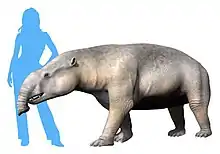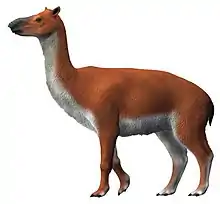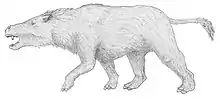Chasicotherium
Chasicotherium is an extinct genus of a large notoungulate mammal known originally from a partial skull and mandible discovered in the Arroyo Chasicó Formation, in the stream of Party of Villarino, Buenos Aires, Argentina. The sediments in which the animal was discovered dates to 10 to 9 million years (Chasicoan). It is known only from the type species, C. rothi. Its weight was approximately 1 tonne (0.98 long tons; 1.1 short tons), being the largest and most recent member of the family Homalodotheriidae. It was a large herbivore of the Miocene Pampas, closely related to Homalodotherium, which also shares the reduced dental formula of the short premaxilla.[2]
| Chasicotherium | |
|---|---|
| Scientific classification | |
| Domain: | Eukaryota |
| Kingdom: | Animalia |
| Phylum: | Chordata |
| Class: | Mammalia |
| Order: | †Notoungulata |
| Family: | †Homalodotheriidae |
| Genus: | †Chasicotherium Cabrera & Kraglievich 1931[1] |
| Species: | †C. rothi |
| Binomial name | |
| †Chasicotherium rothi Ameghino 1887 | |
References
- Cabrera, A. y Kraglievich, L. 1931. Diagnosis previas de los ungulados fósiles del Arroyo Chasicó. Notas preliminares del Museo de La Plata 1: 107-113.
- Bocchino de Ringuelet, A. (2013). Estudio del género Chasicotherium Cabrera y Kraglievich 1931 (Notoungulata - Homaldotheriidae). Ameghiniana, 1(1-2). http://www.ameghiniana.org.ar/index.php/ameghiniana/article/view/1083
This article is issued from Wikipedia. The text is licensed under Creative Commons - Attribution - Sharealike. Additional terms may apply for the media files.




.jpg.webp)



